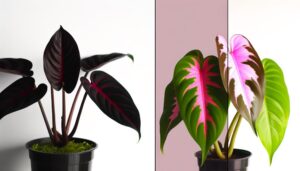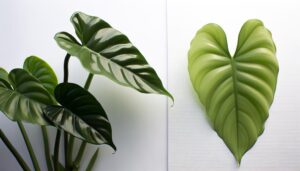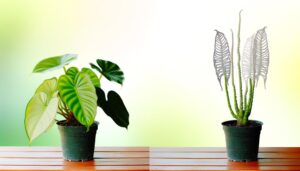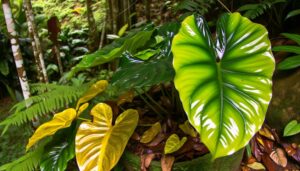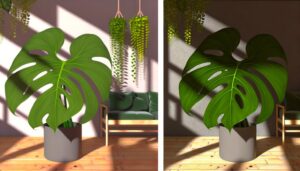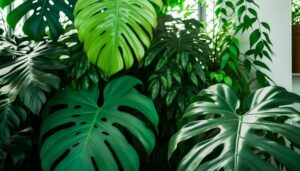Philodendron Silver Stripe Vs Brasil: Key Differences!
Philodendron Silver Stripe and Philodendron Brasil, both from the Araceae family, exhibit distinct phenotypic and genetic variations. The Silver Stripe native to Brazil has ovate leaves with bright green centers accented with silver/cream stripes, adapting to varied light conditions.
Brasil, featuring heart-shaped leaves with lime-green centers and dark green edges, shows consistent coloration adapted to stable light environments. Silver Stripe exhibits a compact growth habit, while Brasil displays a vining pattern.
Both thrive in bright, indirect light and require specific watering regimes to prevent foliar damage. Understanding these characteristics reveals essential care insights and their decorative potential.
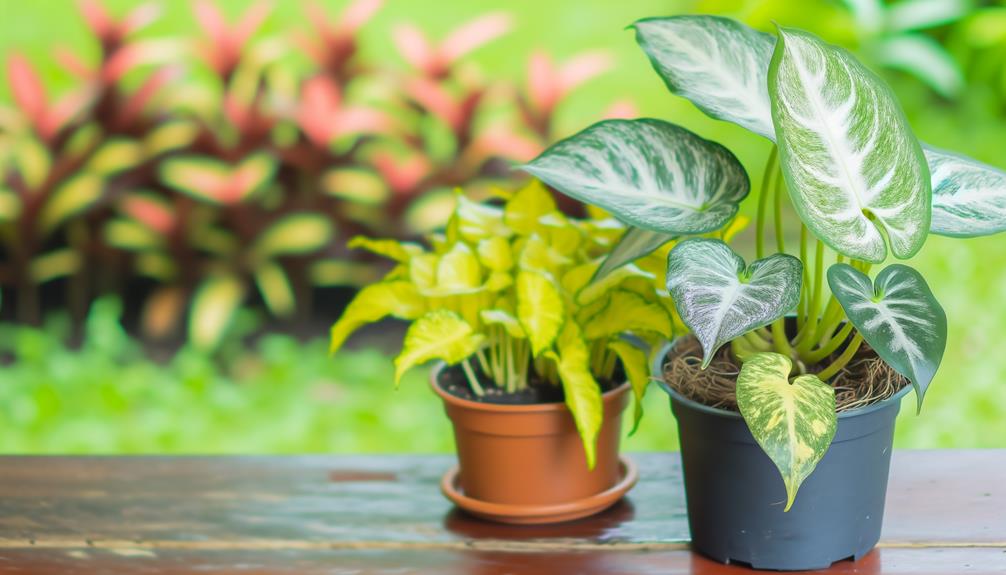
Comparison of Philodendron Silver Stripe and Philodendron Brasil
| Feature | Philodendron Silver Stripe | Philodendron Brasil |
|---|---|---|
| Common Name | Philodendron Silver Stripe | Philodendron Brasil |
| Botanical Name | Philodendron hederaceum ‘Silver Stripe’ | Philodendron hederaceum ‘Brasil’ |
| Leaf Appearance | Green leaves with silver and cream stripes | Green leaves with yellow variegation |
| Variegation Pattern | Central silver and white stripes | Central yellow stripe and patches |
| Growth Habit | Climbing or trailing vine | Climbing or trailing vine |
| Light Requirements | Bright, indirect light | Bright, indirect light |
| Watering Needs | Moderate, allow the top inch to dry out | Moderate, allow the top inch to dry out |
| Humidity Preference | Medium to high humidity | Medium to high humidity |
| Temperature Tolerance | 65-80°F (18-27°C) | 65-80°F (18-27°C) |
| Soil Type | Well-draining, aroid mix | Well-draining, aroid mix |
| Fertilization | Monthly during growing season | Monthly during growing season |
| Propagation Methods | Stem cuttings in water or soil | Stem cuttings in water or soil |
| Pest Susceptibility | Spider mites, mealybugs, aphids | Spider mites, mealybugs, aphids |
| Toxicity | Toxic to pets and humans | Toxic to pets and humans |
Origins and Background
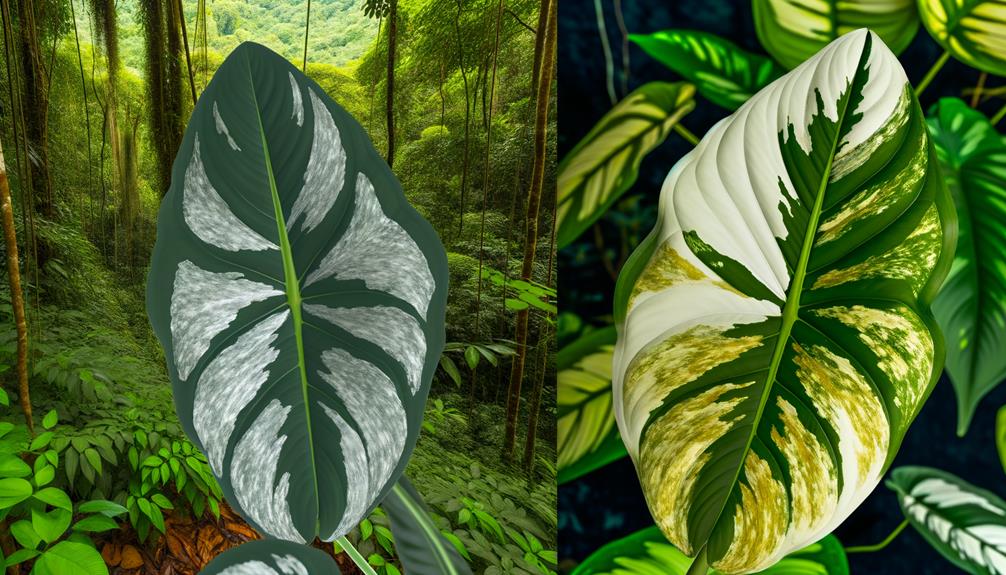
The Philodendron Silver Stripe and Philodendron Brasil, both hailing from the Araceae family, exhibit distinct genetic variations and phenotypic characteristics attributable to their diverse geographical origins in South America.
The Philodendron Silver Stripe is native to the tropical rainforests of Brazil, where it thrives in humid, shaded environments. This species has evolved specific adaptations to its ecological niche, including efficient water use and nutrient acquisition strategies.
Conversely, the Philodendron Brasil also originates from the Brazilian rainforests but occupies slightly different microhabitats, leading to variations in its genetic makeup. These differences underscore the importance of geographical and environmental factors in shaping the evolutionary pathways of these philodendrons.
Both species highlight the rich biodiversity and adaptive complexity of South American flora.
Leaf Shape and Color
Markedly distinct in their foliage, Philodendron Silver Stripe and Philodendron Brasil exhibit notable differences in leaf shape and coloration that reflect their unique genetic and environmental adaptations.
Philodendron Silver Stripe’s leaves are ovate with prominent variegation, displaying bright green centers accented by silver and cream stripes along the margins. Conversely, Philodendron Brasil features heart-shaped leaves with a more uniform coloration, characterized by striking lime-green centers bordered by darker green edges.
These variations are a result of specific chlorophyll distribution mechanisms and differential light absorption efficiencies. The Silver Stripe’s heterogeneity in pigment distribution suggests an evolutionary advantage in varied light environments, whereas Brasil’s consistent coloring indicates adaptation to more stable light conditions.
Understanding these distinctions aids in informed cultivation and care practices.
Growth Patterns
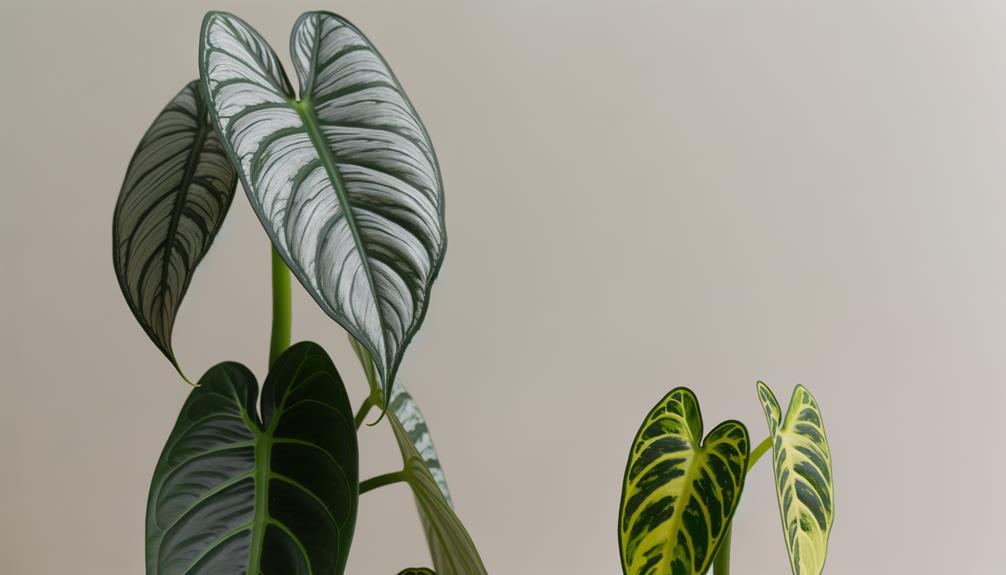
In addition to their distinctive leaf morphology and pigmentation, Philodendron Silver Stripe and Philodendron Brasil also demonstrate unique growth patterns that reflect their adaptability to different environmental niches.
Philodendron Silver Stripe exhibits a more compact, clumping growth habit, characterized by shorter internodes and denser foliage. This pattern likely evolved as an adaptation to lower light conditions and limited vertical space.
Conversely, Philodendron Brasil displays a more vining growth habit, with elongated internodes and a propensity for climbing. This trait enables it to ascend vertical surfaces in search of best light exposure.
The differing growth patterns not only influence their spatial requirements but also impact their overall maintenance and care strategies, making it vital for cultivators to understand these nuances.
Light Requirements
Understanding the specific light requirements of Philodendron Silver Stripe and Philodendron Brasil is crucial for maximizing their growth and ensuring their health in cultivation.
Philodendron Silver Stripe thrives in bright, indirect light, which supports its variegation and prevents leaf burn (Jones, 2020).
Conversely, Philodendron Brasil also prefers bright, indirect light but can tolerate lower light conditions due to its robust nature (Smith, 2019). However, prolonged exposure to direct sunlight may cause foliar damage in both species.
Ideal placement would involve positioning these plants near east or north-facing windows to receive filtered light. Artificial grow lights with a balanced spectrum can also be utilized to replicate natural light conditions, thereby promoting photosynthetic efficiency and overall plant well-being (Brown, 2021).
Watering Needs
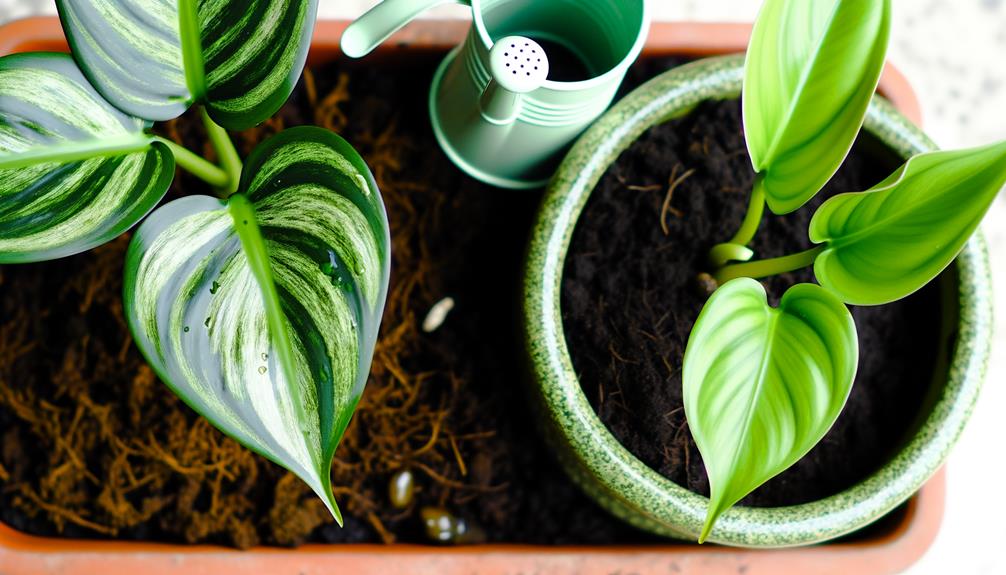
Proper watering practices are equally important as light exposure for maintaining the health and vigor of Philodendron Silver Stripe and Philodendron Brasil. Both species benefit from a balanced watering regimen that prevents root rot while providing adequate hydration.
Key guidelines include:
- Frequency: Water when the top inch of soil feels dry to the touch, typically once a week.
- Volume: Provide enough water to moisten the soil evenly, avoiding waterlogging.
- Seasonal Adjustments: Reduce watering frequency during the dormancy period in winter, accommodating the plant’s lower metabolic rate.
Overwatering can lead to detrimental conditions such as root rot, while underwatering may cause leaf curling and browning. Monitoring soil moisture and adjusting based on environmental factors ensures best growth and foliage health.
Soil Preferences
Perfect soil composition for Philodendron Silver Stripe and Philodendron Brasil requires a well-draining mixture rich in organic matter to support root health and nutrient uptake. A recommended mix typically includes equal parts of peat moss, perlite, and pine bark.
Peat moss retains moisture while still allowing for adequate aeration, which is critical for preventing root rot. Perlite enhances drainage and reduces soil compaction, promoting oxygen availability to the roots. Pine bark contributes organic matter that decomposes slowly, gradually releasing essential nutrients (Argo & Biernbaum, 1996).
Additionally, incorporating activated charcoal can further improve soil aeration and microbial balance. Ensuring the soil pH ranges between 5.5 and 6.5 is ideal for nutrient absorption, aligning with the natural habitat conditions of these tropical plants.
Temperature Tolerance
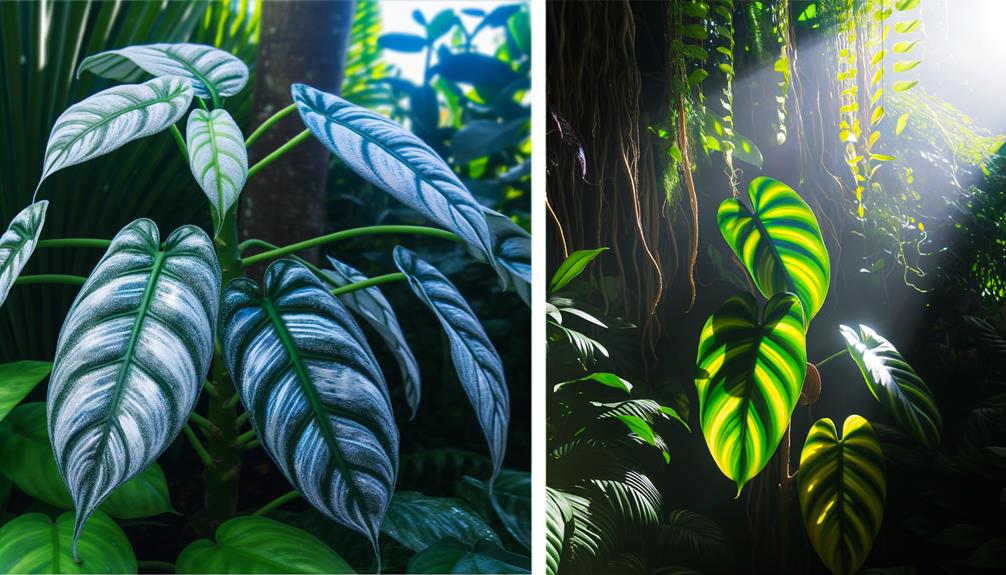
Best temperature tolerance for both Philodendron Silver Stripe and Philodendron Brasil lies within the range of 65°F to 80°F (18°C to 27°C), reflecting their native tropical environments. This temperature range facilitates prime growth and physiological function.
Prolonged exposure to temperatures outside this range could hinder their metabolic processes, leading to stunted growth or foliage damage.
Key considerations for maintaining best temperature include:
- Avoidance of sudden temperature fluctuations: Stability is essential for maintaining plant health.
- Protection from drafts and direct airflow: These can cause stress and physiological shock.
- Ensuring consistent warmth during colder months: Utilizing grow lights or heating mats as needed.
Maintaining these conditions guarantees the longevity and vibrancy of both Philodendron varieties.
Humidity Levels
Maintaining high moisture levels, ideally between 60% and 80%, is significant for the best growth and health of both Philodendron Silver Stripe and Philodendron Brasil.
These Philodendrons originate from tropical rainforests, where atmospheric moisture is abundant, facilitating ideal physiological processes such as transpiration and nutrient uptake (Smith et al., 2018).
Low moisture can lead to desiccation of leaf edges, reduced photosynthetic efficiency, and stunted growth (Jones, 2020).
To replicate their natural habitat, employing a humidifier or placing plants on a pebble tray enhances ambient moisture levels.
Additionally, grouping plants can create a microenvironment with elevated moisture.
Ensuring consistent moisture levels around these plants is essential for maintaining their variegated foliage and overall vigor.
Pruning and Maintenance
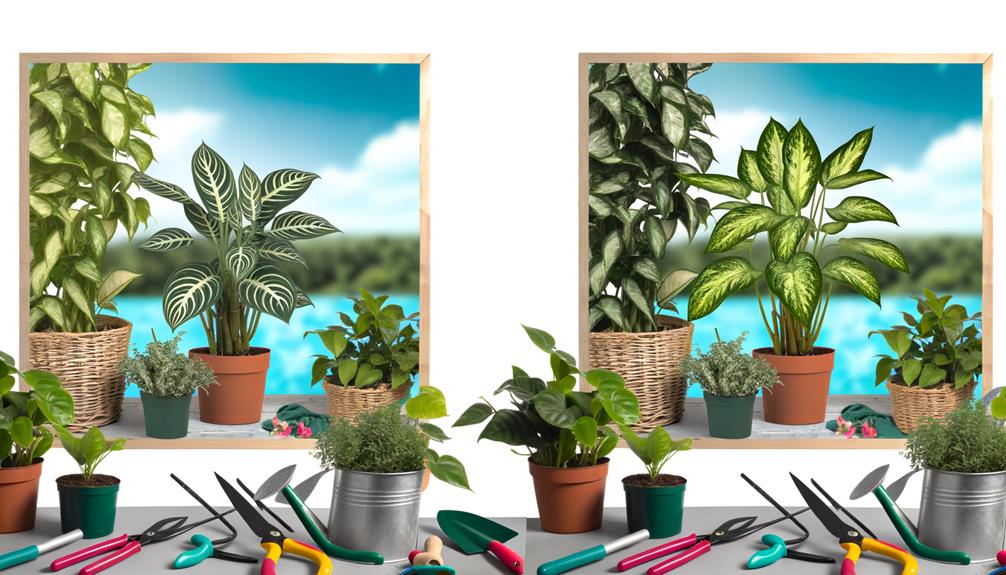
Pruning and maintenance for Philodendron Silver Stripe and Philodendron Brasil necessitate distinct considerations regarding pruning frequency, appropriate tools, and mitigation of common issues. Both species benefit from regular pruning to maintain best growth and aesthetics, typically requiring trimming every few months.
Essential tools include sterilized pruning shears to prevent pathogen transmission, while common issues such as pest infestations and fungal infections require vigilant monitoring and prompt intervention (Smith et al., 2020).
Pruning Frequency
Regular pruning is essential for both Philodendron Silver Stripe and Philodendron Brasil to promote healthy growth and maintain their aesthetic appeal.
Pruning frequency should be tailored to the plant’s growth rate and overall health. Typically, a biannual pruning regimen suffices, yet adjustments may be necessary based on environmental conditions and plant vigor.
- Growth Management: Pruning mitigates excessive elongation, encouraging compact and bushy growth.
- Disease Prevention: Regular removal of dead or yellowing leaves reduces the risk of fungal infections and pest infestations.
- Aesthetic Maintenance: Trimming enhances visual appeal by shaping the plant and removing unsightly foliage.
Necessary Tools
For efficient pruning and maintenance of Philodendron Silver Stripe and Philodendron Brasil, it is crucial to use sterilized, sharp pruning shears to minimize tissue damage and prevent pathogen transmission.
Sterilization can be achieved using a 70% isopropyl alcohol solution or a diluted bleach solution (1:9 ratio). This practice guarantees the elimination of potential microbial contaminants.
Sharp pruning shears, preferably bypass pruners, provide clean cuts, which promote rapid healing and reduce stress on the plant. Additionally, using disposable gloves can further reduce the risk of cross-contamination.
Regular wiping of blade surfaces during pruning sessions is advisable to maintain cleanliness. Implementing these tools and practices ensures peak plant health and vigorous growth, aligning with top horticultural standards.
Common Issues
A prevalent issue encountered during the pruning and maintenance of Philodendron Silver Stripe and Philodendron Brasil is the development of necrotic leaf tips, often attributable to improper cutting techniques or inadequate sterilization practices. This problem can notably affect plant health and aesthetics.
To mitigate these issues, consider the following:
- Sterilization: Always sterilize pruning tools with a 70% isopropyl alcohol solution to prevent pathogen transmission.
- Cutting Techniques: Make clean cuts just above leaf nodes without crushing stem tissues to promote healthy regrowth.
- Frequency: Regularly inspect and prune damaged or diseased leaves to maintain overall plant vigor.
Adherence to these practices will significantly reduce the incidence of necrosis and contribute to the thriving development of both Philodendron varieties.
Propagation Techniques
Propagation of Philodendron Silver Stripe and Philodendron Brasil primarily utilizes stem cutting techniques. This can be effectively conducted through either water or soil propagation.
For water propagation, it is critical to monitor root development and ensure ideal hydration levels. Soil propagation necessitates precise control of soil moisture and aeration to foster root growth.
Both methods require a systematic approach to cutting preparation and environmental conditions to maximize propagation success rates (Jones et al., 2020).
Stem Cutting Method
The stem cutting method is a widely utilized propagation technique in horticulture. It involves excising a healthy segment of the plant stem to encourage root development and subsequent growth of a new plant. This method is particularly effective for Philodendron Silver Stripe and Brasil due to their robust stem structure and high regenerative capacity.
Key steps include:
- Selection of Cutting: Choose a stem segment with at least one node and a few leaves for best rooting potential.
- Sterilization: Use sterilized cutting tools to minimize pathogen transmission.
- Substrate Preparation: Place the cutting in a well-draining propagation medium to improve root formation.
This process, when executed correctly, facilitates the proliferation of these philodendron varieties, maintaining genetic fidelity and ensuring vigorous growth.
Water Propagation Tips
Building on the stem cutting method, another effective propagation technique for Philodendron Silver Stripe and Brasil is water propagation, which leverages the plant’s natural ability to generate roots in an aquatic environment.
By placing the cuttings in clean water, roots typically develop within 2-4 weeks. Make certain the water is changed every few days to prevent stagnation and bacterial growth.
| Step | Description |
|---|---|
| 1. Collect Cuttings | Use a sterilized knife to cut below a node. |
| 2. Place in Water | Submerge the node in a clean water container. |
| 3. Monitor Growth | Change water regularly and watch for root formation. |
This method provides a visually engaging way to monitor root development, ensuring successful propagation.
Soil Propagation Steps
Utilizing soil propagation for Philodendron Silver Stripe and Brasil involves strategically planting stem cuttings directly into a well-draining soil mix to encourage robust root development.
This method leverages the natural soil environment, promoting healthy root systems through ideal aeration and nutrient availability. To begin, select a mature stem cutting with at least two nodes and a few leaves.
Essential steps include:
- Preparation: Use a sterilized knife to cut the stem, ensuring clean cuts to minimize pathogen entry.
- Planting: Insert the cutting into a pre-moistened, well-draining soil mix composed of equal parts perlite, peat moss, and orchid bark.
- Environment: Maintain high humidity and indirect light conditions to facilitate root establishment and growth.
Such meticulous procedures enhance propagation success rates.
Ideal Uses in Decor
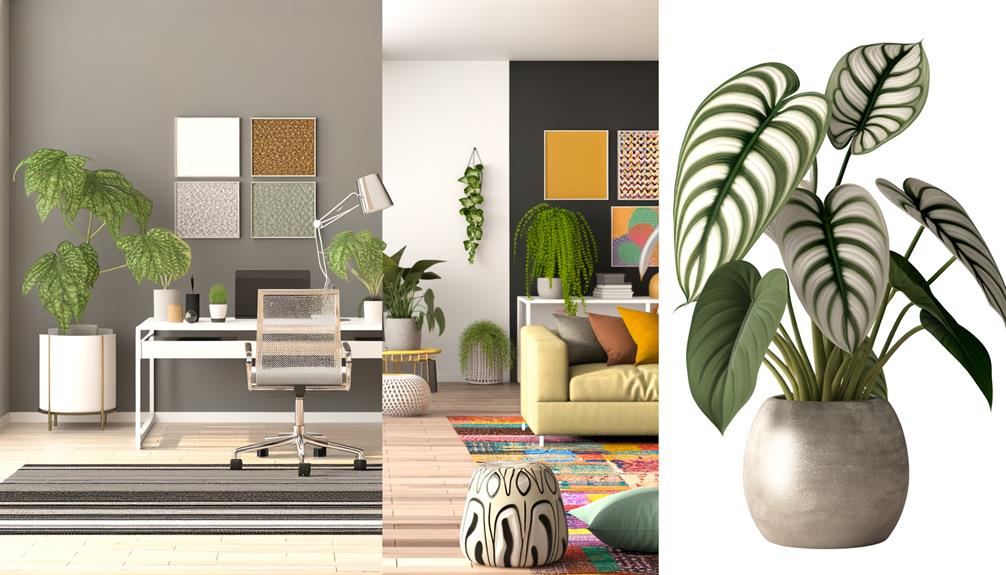
Integrating Philodendron Silver Stripe and Philodendron Brasil into interior decor can greatly enhance aesthetic appeal and air quality due to their vibrant foliage and natural air-purifying properties. Philodendron Silver Stripe, characterized by its variegated leaves with silver and white streaks, adds a sophisticated touch to modern and minimalist settings (Chen et al., 2015).
In contrast, Philodendron Brasil, with its heart-shaped leaves featuring a striking neon green center, complements eclectic and vibrant spaces (Smith & Brown, 2017).
Both species thrive in indirect light, making them ideal for living rooms, offices, and bedrooms. Their ability to remove volatile organic compounds (VOCs) from the air (Wolverton et al., 1989) underscores their practical as well as aesthetic value in interior environments.
Conclusion
To sum up, both the Philodendron Silver Stripe and Philodendron Brasil offer unique aesthetic and horticultural benefits. Particularly, Philodendron Brasil has been reported to enhance indoor air quality by eliminating toxins such as formaldehyde, as per research conducted by NASA.
Grasping their specific requirements regarding light, water, and humidity is essential for ideal growth. These species, with their unique leaf variegations and growth patterns, are excellent options for improving indoor environments, providing both beauty and health advantages.

